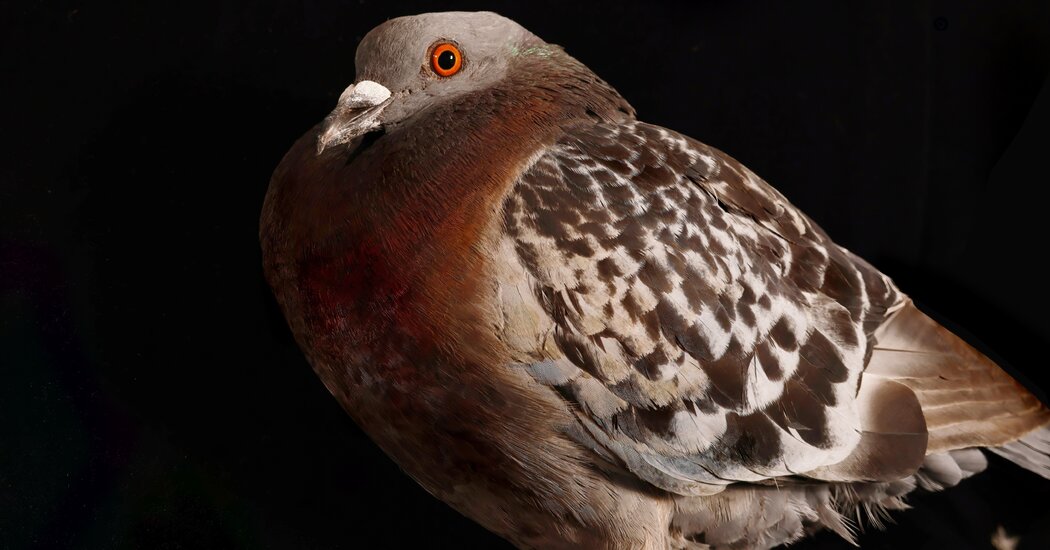If familiarity breeds contempt, then no wild animal has made itself more loathsome to humanity than the city pigeon. They nest in inconvenient places, overcrowd city squares and corrode stonework with their acidic droppings. One of the first things I noticed when I moved to Berlin 10 years ago was something odd about the pigeons here: Some of them were pretty, far comelier than Manhattan pigeons, who were feral descendants of domesticated rock doves with cigar-stub heads and greaseball breasts. I assumed that the Berlin birds’ handsome white neck patches, soft pink chests and candy-corn beaks were standard traits for Germany’s city pigeons — which meant they were also still messy, diseased and persistent pests.
It was only when I started birding that I realized these more attractive birds weren’t actually city pigeons but a different species entirely called the wood pigeon. Typically forest birds native to Europe and Asia, wood pigeons have rapidly expanded into European cities in recent decades. Many cityfolk probably haven’t noticed the newcomers because they don’t know the differences between city pigeons and their wood-dwelling cousins.
Recognizing the diversity of pigeons is like seeing dispersed light in a rainbow: There are more than 350 species of birds in the family Columbidae, including blue pigeons in Madagascar, pink pigeons in Mauritius, maroon pigeons in São Tomé and metallic pigeons in Indonesia and the Pacific. The green pigeons of Africa and Asia have accents splashed on their emerald base, with yellow-footed, pink-necked and cinnamon-headed varieties. Hike high into the Himalayas or deep into the Australian outback, and you’ll find that pigeons there have adapted to extreme conditions: They inhabit every region of the planet except the poles.
Although pigeons can be as fetching as parrots and nearly as widespread as songbirds, they generally receive far less respect and admiration from birders and scientists. “It appears at first rather surprising that the pigeons are so successful,” the British ornithologist Derek Goodwin once wrote, considering that the small-headed birds often give “the impression of being rather stupid.” The wood pigeon is typical in this regard. In parks, I saw them startle people by exploding out of bushes in a needless panic. In trees, they ventured onto tiny branches that could not support their weight. The males wooed females with courteous fantail bows but blew their chances with impatient, aggressive pecks. A popular bird-watching app described them, in similar language to Goodwin, as “often rather unaware.”
As I read more about the Columbidae, though, I came to appreciate pigeons for more than just their beauty. Their big appetites are crucial to the health of forests around the globe. Researchers observing fig trees in Malaysia once found that green pigeons consumed far more fruit than any other animal in the jungle, visiting some trees more often than all other animals combined. Most animals defecate seeds near the parent tree, but pigeons are long-distance fliers who retain seeds in their guts longer than other frugivores. Pigeons’ ability to fly across oceans is probably why common species of trees grow on the many isolated islands of the Indian and Pacific Oceans. After the Indonesian volcano Krakatoa destroyed all life on nearby islands in 1883, a pigeon was the first frugivore to return. Any seeds in its droppings would have helped regenerate fruit-bearing trees.
Wood pigeons are the animals most responsible for transporting large seeds like olive pits and cherry stones around Europe. A wood pigeon on my balcony could down six or seven whole peanuts in their shells, one after the other. The more I watched them, the more I realized they were changing the city’s composition. Unlike city pigeons, who seem hardened by centuries of urban living, wood pigeons have not yet lost the innocence and ambition of fresh arrivals from the countryside. They’ve learned to scavenge breadcrumbs on the sidewalks like their city cousins, but they also eat fruits and seeds from dozens of exotic, ornamental trees. Some wood pigeons reverse-commute, sleeping overnight in cities but flying daily to forage farmland grains.
Ecologists coined the word “synurbanization” to describe the adaptation of wild plants and animals to cities. And in some ways, it’s a two-way street. The birds drew my attention to treetops, cemeteries, overgrown lots and other places that the writer Richard Mabey calls “the unofficial countryside,” in which wood pigeons’ coos became soothing notes in a Berlin soundscape of shrieking sirens and wall-rattling techno beats.
Wood pigeons have helped me to look at city pigeons more kindly. Whether they’re nesting behind shop signs or pecking at detritus on the street, they seem less like parasites than pioneers who’ve taken up the challenge of rewilding the grossest corners of humanity. They’ve also reminded me how, though we tend to think of the urban and the wild in juxtaposition, superimposition — layering one thing on top of another so the ways they’re entwined become visible — is more often the case. We don’t need to escape to the woods for contact with wildlife; cities are habitats, too, governed by ecology and evolution. To observe this and to name our wild neighbors is to embrace our natural surroundings. For me, watching wood pigeons is a reminder that familiarity need not breed contempt; it can also plant the seeds of renewed curiosity.
The post This Reviled Pest Is the Unsung Hero of Every Major City in the World appeared first on New York Times.




